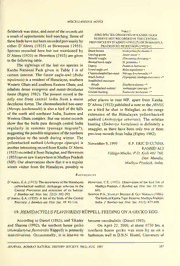
Hemidactylus Flaviviridis Ruppell Feeding on a Gecko Egg PDF
Preview Hemidactylus Flaviviridis Ruppell Feeding on a Gecko Egg
MISCELLANEOUS NOTES fieldworkwas done, andmostofthe records are Table1 a resultofopportunistic birdwatching. Some of BIRDSPECIESOBSERVEDINKANHATIGER RESERVENOTRECORDEDINTHECENTRAL thesebirdshavenotbeenrecordedpreviouslyby PROVINCESBYD’ABREU(1935)[*]ORINMADHYA either D’Abreu (1935) or Hewetson (1955). PRADESHBYHEWETSON(1995)[+] Species recorded here but not mentioned by Blackbittern Ixobiychusflavicollis+ D’Abreu (1935) or Hewetson (1955) are given Greylaggoose Anserwiser+ Bonelli’seagle Hieraaetusfasciatus+ in the following table. Bootedhawkeagle H.pennatus+ The sightings of the last six species in Osprey Pandionhaliaetus+ Kanha National Park given in Table 1 is of Foresteagleowl Bubonipalensis+ certain interest. The forest eagle-owl Bubo Chestnutheadedbee-eater Meropsleschenaulti+* ( Blackbulbul Hypsipetesmadagascariensis+* nipalensis) is a resident ofHimalayas, southern Smallbilledmountain Western Ghats and southern Eastern Ghats, and thrush Zootheradauma+* inhabits dense evergreen and moist-deciduous Yellowbackedsunbird Aethopygasiparaja+* Ortolanbunting Emberizahortulana+* forest (Ripley 1982). The present record is the only one from central India from a moist other places in east MP, apart from Kanha. deciduous forest. The chestnutheaded bee-eater D’Abreu (1913) published a note in theJBNHS {Merops leschenaulti) is also a bird ofthe hills on a bird he shot in Balaghat, as the range of the north and northeast India, Eastern and extension of the Himalayan yellowbacked Western Ghats complex. But our recent records sunbird Aethopyga seheriae). The ortolan ( show that the birds pass through central India bunting (Emberiza hortulana) is definitely a regularly in summer (passage migrant?), straggler, as there have been only two or three suggestingthepossiblemigrationofthenorthern previous records from India (Ripley 1982). population to the south during winter. The yellowbacked sunbird (Aethopyga sipcircijci) is November9, 1999 E.P. ERICD’CUNHA anotherinterestingrecordfromKanha. D’Abreu RASHIDALI (1935)recordeditfromBalaghat, andHewetson Village-Mocha, P.O. Kisli 481 768, (1955)neversawitanywhereinMadhyaPradesh Dist. Mandla, (MP). Our observations show that it is a regular Madhya Pradesh, India. winter visitor from the Himalayas, possibly to ReferENCES D’Abreu,E.A.(1913):TheOccurrenceoftheHimalayan Hewetson, C.E. (1955): Observation ofthe bird life of yellowbacked sunbird, Aethopyga seheriae in the MadhyaPradesh.J. Bombaynat.Hist.Soc. 53:595- Central Provinces and extension of its habitat. 645. J. Bombaynat. Hist. Soc. 22(2): 392-393. Newton P.N., Stanley Breider& GuyNorman (1986): D’Abreu, E.A. (1935): AlistofthebirdsoftheCentral ThebirdsofKanhaTigerReserve,MadhyaPradesh, Province.J. Bombaynat. Hist.Soc. 38:95-116. India.J. Bombaynat. Hist. Soc. 83(3):477-498. 19. HEMIDACTYLUSFLAVIVIRIDISRUPPELL FEEDING ON A GECKO EGG According to Daniel (1983), and Tikader become cannibalistic (Daniel 1983). and Sharma (1992), the northern house gecko On April 22, 2000, at about 0730 hrs, a (Hemidactylusflaviviridis Ruppell) is primarily northern house gecko was seen by us on a insectivorous. Occasionally, it is known to bathroom wall in D.B.N. Hostel, University of JOURNAL, BOMBAYNATURAL HISTORYSOCIETY, 98(2),AUG. 2001 287 MISCELLANEOUSNOTES Rajasthan, Jaipur, with a spherical white egg in house geckos were also seen below various its mouth. From its colour, size and general hideouts in ones and twos. The area was appearance, the egg looked like that of apparentlyafavouritebreedingsiteofthegeckos. H.flaviviridis. The gecko was moving upwards The egg was perhaps lifted from one of the andafterabout2.5 m, itbroke the eggshell with clutches fromthe same locality. twoorthreeblows.Theemptyeggshellwasthen Feeding on gecko eggs by H. flaviviridis thrown away. The gecko positioned itselfright is an unusual behaviour for this species, hence below the flowing yolk and started licking itup worth placing on record. from the lower-most point, gradually moving upwards. While it was licking the yolk, another January 18, 2001 SATISHKUMARSHARMA gecko appeared and approached it, but was Range ForestOfficer, chasedaway. Itconsumedthe entireyolkwithin Phulwari WildlifeSanctuary, sevenminutes.Thegeckothenmovedtoanother Kotra 307 025, District Udaipur, wall. Rajasthan, India. The empty eggshell was c. 1 1 mm in YOGESH SHARMA diameter. Afterwatchingthisstrangebehaviour, Department ofBotany weexaminedallbathsandtoiletsminutely.Many University ofRajasthan, geckos were seen on the walls. Many eggs of Jaipur 302 004, Rajasthan, India. References Daniel,J.C.(1983):TheBookofIndianReptiles,Bombay Tikader,B.K.&R.C.Sharma(1992):HandbookofIndian NaturalHistorySociety,Bombay. 1-141 pp. Lizards.ZoologicalSurveyofIndia,Calcutta. 1-241pp. 20. UROPELTID SNAKES ANDTHEIRPREDATORS Birds are among the many predators of on being disturbed by the crowd of people uropeltidsnakes.Rajendran(1985)hasreported watching, the snake took the opportunity and predationbydomesticfowl,turkey,guineafowl, disappeared into the soil peafowl, owls and wild pigs on uropeltids II. Two other instances are from exposed by digging earth. We have observed Anaimalai hill ranges, Tamil Nadu. some new predators as described below. (a) On August 21. 1998 at 1810 hrs, in I. Thehousecrow(Corvussplendens)was theforestfragmentofVaratuparai, weobserved seen to prey on Uropeltis ellioti at Matighatta a Malabar whistling thrush (Myiophonus inHassandistrictofKarnataka State, onAugust horsfieldii) preying on Uropeltis ocellatus. We 15, 1999 at 1440 hrs, in a coconut and areca were sitting among the tea bushes adjacent to a farm. It had just rained and the soil was wet. patch offorest, when we saw a snake come out Weobservedthesnakecrawlingonopenground, ofthesoil,nearthebaseofateabush(Camellia betweenthearecapalms.Ahousecrowswooped thea). A thrush flew down and sat on a branch down and pecked at the snake, but did not of the tea bush, just above the snake, and attemptto take it away. The snake immediately watched it. A few seconds later, the thrush coiled itselfaround one ofthe areca palms and caughtthe crawling snake atthe mid-bodywith tried to burrow into the soil, but the crow did its beak. It carried the snake into another tea notallow itto do so. Whenthe crowmoved off bush and startedtearing open thebody. All this 288 JOURNAL, BOMBAYNATURAL HISTORYSOCIETY, 98(2), AUG. 2001
